Adroddiad sefyllfaol COVID-19: 20 Mai 2021
Diweddariad gan Gell Wybodaeth COVID-19 a'r Grŵp Ymgynghorol Diogelu Iechyd.
Efallai na fydd y ffeil hon yn gyfan gwbl hygyrch.
Ar y dudalen hon
Crynodeb adroddiad sefyllfaol COVID-19
Y pwyntiau allweddol i’w nodi
Mae Cymru ar Lefel Rhybudd 2.
Mae trosglwyddiadau COVID-19 yn cynyddu ychydig yn gyffredinol ond yn gymharol isel. Mae’r amcangyfrif consensws ar gyfer y rhif atgynhyrchu yng Nghymru rhwng 0.7 a 1.0. Ffynhonnell: SPI-M/SAGE, 11 Mai 2021.
Mae achosion COVID-19 yn gymharol isel ar draws y rhan fwyaf o Gymru. Mae canran y bobl sy’n profi’n bositif am COVID-19 yn parhau’n gymharol isel. Ffynhonnell: PHW
Mae’r pwysau sydd ar y GIG oherwydd COVID-19 yn parhau i wella ac mae ar y lefel isaf yn awr ers dechrau cofnodi ar 1 Ebrill 2020. Ffynhonnell: Data Gweithredol GIG Cymru
Fel yr oedd ar 19 Mai, mae 11 achos arall o’r amrywiolyn VOC-21APR-02 (B.1.617.2, a nodwyd gyntaf yn yr India) wedi cael eu canfod yng Nghymru, gan ddod â’r cyfanswm i 22 o achosion a gadarnhawyd. Aseswyd bod ganddo gyfradd twf uwch o’i gymharu â’r amrywiolyn amlycaf, B.1.1.7, a allai olygu y bydd yn cymryd lle’r amrywiolyn amlycaf yn y pen draw os caniateir iddo ledaenu. Gwelwyd arwyddion o dwf cyflymach a chyflymach o’r amrywiolyn hwn mewn rhannau o’r DU lle y mae wedi sefydlu, sy’n cynnwys achosion a fewnforiwyd ac achosion a gafwyd yn y wlad hon. Nid oes digon o ddata ar hyn o bryd i asesu faint o bosibilrwydd sydd y gallai’r amrywiolyn hwn ddianc rhag ymateb imiwnyddol, ond ceir arwyddion cynnar y gallai ddianc rhag effaith brechlyn i ryw raddau.
O ran brechu, yn ystod yr wythnos a ddaeth i ben ar 16 Mai 2021, cafodd cyfanswm o 2.95 miliwn o ddosau o frechlyn COVID-19 eu rhoi yng Nghymru. O’r 2.95 miliwn o ddosau a roddwyd yn genedlaethol, dosau cyntaf oedd 2.05 miliwn ohonynt ac ail ddosau oedd 0.92 miliwn ohonynt. Os na cheir unrhyw ymddygiadau diogelu eraill, ni fydd y niferoedd presennol sydd wedi’u brechu yn diogelu ar lefel y boblogaeth gyfan. Ffynhonnell: PHW
Dangosyddion allweddol
Mae’r rhan fwyaf o ddangosyddion allweddol yn parhau i ostwng neu’n parhau’n sefydlog, yn dilyn cyfnod o drosglwyddiadau uchel ym mis Rhagfyr a mis Ionawr.
Sylwer bod y saethau yn cynrychioli newid mewn cymhariaeth ar gyfer yr wythnos ddiwethaf.
| Gwerth cyfredol (15/05/21) | Newid ers yr wythnos flaenorol (08/05/21 – 15/05/21 oni nodir fel arall) | ||||
|---|---|---|---|---|---|
| Newid mewn canran | Newid mewn gwerth | ||||
| Cyfradd yr achosion a gadarnhawyd (swm 7 diwrnod treigl fesul 100k) | 9 | +5% | - | 0 | |
| Cyfradd achosion a gadarnhawyd yn y rheini dros 60 oed (swm 7 diwrnod treigl fesul 100k) | 6 | -19% | - | (-1) | |
| Positifedd profion (Cyfartaledd treigl 7 diwrnod) | 1.00% | +5% | - | (0.0 percentage points) | |
| Y boblogaeth yr amcangyfrifir bod ganddi COVID-19 (cyffredinrwydd)1 | 0.02% | 0% | - | (0.00 percentage points) | |
| Capasiti’r GIG – Derbyniadau2 | 3 | -50% | - | (-3) | |
| Marwolaethau ONS (swm 7 diwrnod)3 | 4 | +33% | - | (+1) | |
| Marwolaethau PHW (swm 7 diwrnod) | 2 | -67% | - | (-4) | |
- Mae data diweddaraf yr Arolwg Heintiadau COVID-19 ar gyfer y cyfnod o 9 Mai i 15 Mai 2021.
- Y cyfartaledd treigl saith diwrnod hyd at y dyddiad presennol o gleifion y cadarnhawyd bod ganddynt COVID-19 – nid yw’n cynnwys cleifion yr amheuwyd bod ganddynt COVID-19 neu sy’n gwella.
- Mae data marwolaethau diweddaraf ONS hyd at 7 Mai 2021(yn hytrach na 15 Mai 2021) ar gyfer y gwerth cyfredol. Defnyddir data hyd at 30 Ebrill 2021 ar gyfer y newid ers yr wythnos flaenorol.
What is the current status of the epidemic?
| Local Authority | Number | % of All Wales Total | Case Incidence per 100,000 | Incidence threshold reached | Change from previous week |
|---|---|---|---|---|---|
| Newport | 46 | 15.20% | 29.7 | 25 to < 50 | 5% ↑ |
| Cardiff | 66 | 21.90% | 18 | 15 to < 20 | 18% ↑ |
| Wrexham | 16 | 5.30% | 11.8 | Under 15 | -11% ↓ |
| Swansea | 28 | 9.30% | 11.3 | Under 15 | 115% ↑ |
| Torfaen | 10 | 3.30% | 10.6 | Under 15 | 100% ↑ |
| Blaenau Gwent | 7 | 2.30% | 10 | Under 15 | 600% ↑ |
| Carmarthenshire | 17 | 5.60% | 9 | Under 15 | -19% ↓ |
| Vale of Glamorgan | 12 | 4.00% | 9 | Under 15 | 140% ↑ |
| Merthyr Tydfil | 5 | 1.70% | 8.3 | Under 15 | 25% ↑ |
| Bridgend | 12 | 4.00% | 8.2 | Under 15 | 200% ↑ |
| Gwynedd | 10 | 3.30% | 8 | Under 15 | 11% ↑ |
| Conwy | 9 | 3.00% | 7.7 | Under 15 | 80% ↑ |
| Neath Port Talbot | 11 | 3.60% | 7.7 | Under 15 | 22% ↑ |
| Ceredigion | 5 | 1.70% | 6.9 | Under 15 | -17% ↓ |
| Monmouthshire | 5 | 1.70% | 5.3 | Under 15 | -17% ↓ |
| Powys | 7 | 2.30% | 5.3 | Under 15 | -53% ↓ |
| Flintshire | 8 | 2.60% | 5.1 | Under 15 | -11% ↓ |
| Caerphilly | 9 | 3.00% | 5 | Under 15 | -25% ↓ |
| Pembrokeshire | 6 | 2.00% | 4.8 | Under 15 | -62% ↓ |
| Rhondda Cynon Taf | 9 | 3.00% | 3.7 | Under 15 | -44% ↓ |
| Isle of Anglesey | 2 | 0.70% | 2.9 | Under 15 | -33% ↓ |
| Denbighshire | 2 | 0.70% | 2.1 | Under 15 | -60% ↓ |
| Unknown | 0 | 0.00% | - | -100% ↓ | |
| Total | 302 | 100.00% | 9.6 | Under 15 | 7% ↑ |
At a Wales level, on 14 May, the 7-day rolling incidence of COVID-19 cases and the percentage of people testing positive for COVID-19 have increased slightly since last week.
The SAGE/ SPI-M consensus estimate of Reproduction number (Rt) is 0.7 - 1.0 (as at 11 May 2021). When we look at reproduction numbers using PHW positive test data only (see table below) - a more timely estimate but limited by variation in testing – we see a reproduction number estimate of 1.07 for Wales. At local health board level, there is considerable variation in the reproduction number (cases only) estimate. The central estimate of the reproduction number (cases only) is at or above 1 for the Swansea Bay, Aneurin Bevan, Cardiff & Vale, Powys and Betsi Cadwaladr Health Boards.
7-day cumulative case incidence remains low across Wales, with only Newport and Cardiff above 15 cases per 100,000 population. At a Wales level, cases per 100,000 is currently at 9.6 per 100,000 population. This is a slight increase compared to the previous report (9.0 per 100,000 population).
Incidence varies by local authority and age. Newport is the only local authority with a case incidence rate above the threshold of 25 cases per 100,000. However, the case incidence for Newport has decreased over the past week.
The table below also provides estimates of doubling and halving times based on COVID-19 positive test data. In this table, halving times are positive, whilst doubling times are negative. The 95% confidence intervals are showing in brackets after the central estimate. An asterisk (*) means that there are small numbers and estimates should be treated with caution. Local health board level estimates of Rt and halving times will be unstable when incidence is low.
| Area | Rt (95% CI) | Halving time (95% CI) |
|---|---|---|
| All Wales | 1.07 (0.97 to 1.17) | 24.1 (9.6 to -46.5) DOUBLING |
| Swansea Bay UHB | 1.63 (1.23 to 2.07) | 6.6 (3.8 to 24.9) DOUBLING |
| CTM UHB | 0.93 (0.66 to 1.24) | 58.9 (9.2 to -13.3) |
| Aneurin Bevan UHB | 1.13 (0.93 to 1.35) | 15.4 (7.1 to -82.1) DOUBLING |
| Cardiff & Vale UHB | 1.24 (1.02 to 1.48) | 11.0 (4.4 to -22.9) DOUBLING |
| Hywel Dda UHB | 0.75 (0.54 to 0.99)* | 10.8 (6.5 to 31.1)* |
| Powys THB | 1.26 (0.80 to 1.79)* | 58.0 (6.2 to -7.9)* |
| Betsi Cadwaladr UHB | 0.98 (0.76 to 1.22) | 65.3 (9.5 to -13.4) DOUBLING |
Cases per 100k (PHW Data) (7 day rolling sum)
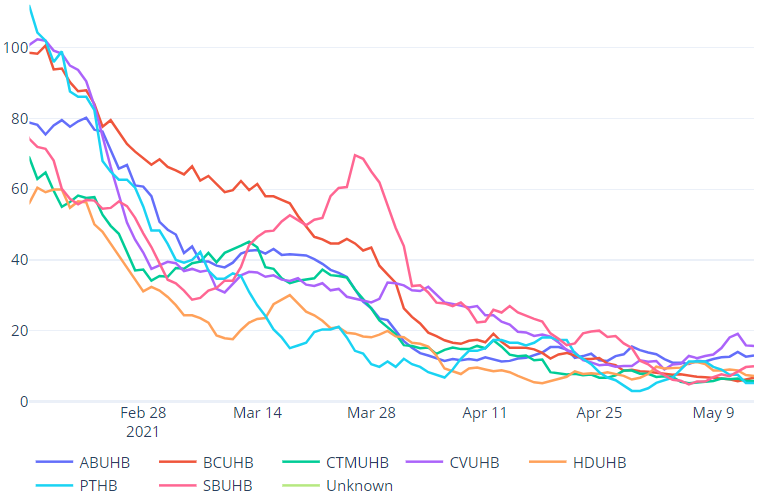
Cases per 100k by age (PHW Data) (7 day rolling sum)
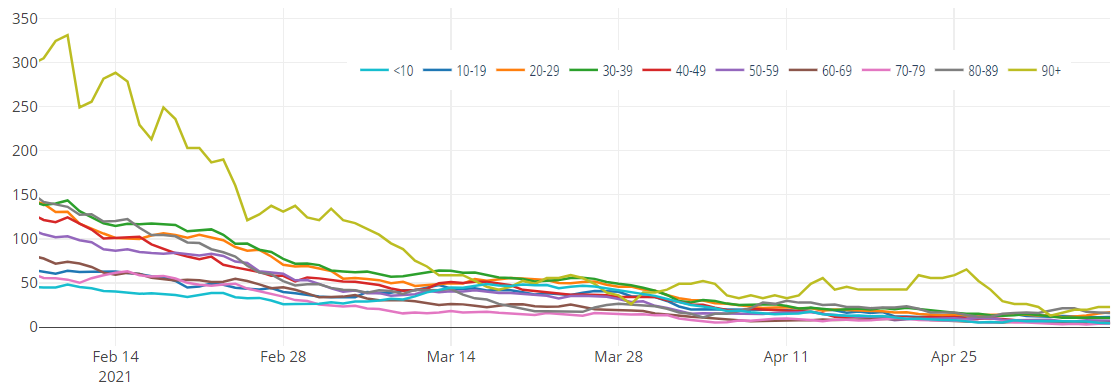
Data as at 12:00PM 19 May 2021 unless otherwise specified
What is the situation with the NHS and social care?
COVID-19 pressure on the NHS continues to improve and is now at the lowest levels since reporting began on 1 April 2020. As at 19 May 2021 there were 171 COVID-19 related patients (Suspected, Confirmed and Recovering) occupying a hospital bed. Confirmed cases constitute 18 of the total, and are at similar levels to mid-September 2020.
There are three Suspected or Confirmed COVID-19 patients in critical care beds in Wales. This is 161 lower than the maximum COVID-19 position of approximately 164. Levels are currently similar to those seen in early September 2020. The total number of patients in critical care for COVID-19 and non-COVID-19 stands at 151, one less than the historic maximum critical care capacity of approximately 152.
The situation with care homes remains stable with a relatively low number of care home incidents across Wales.
Up to 6 May 2021, 5 (0.5%) adult care homes in Wales notified CIW of one or more confirmed cases of COVID-19, in staff or residents, in the past 7 days. This has remained unchanged from the 7 days up to the 29 April 2021. The number of notifications is now at the lowest since the beginning of the reporting period on 16 December 2020.
Confirmed hospital occupancy (7 day rolling average)
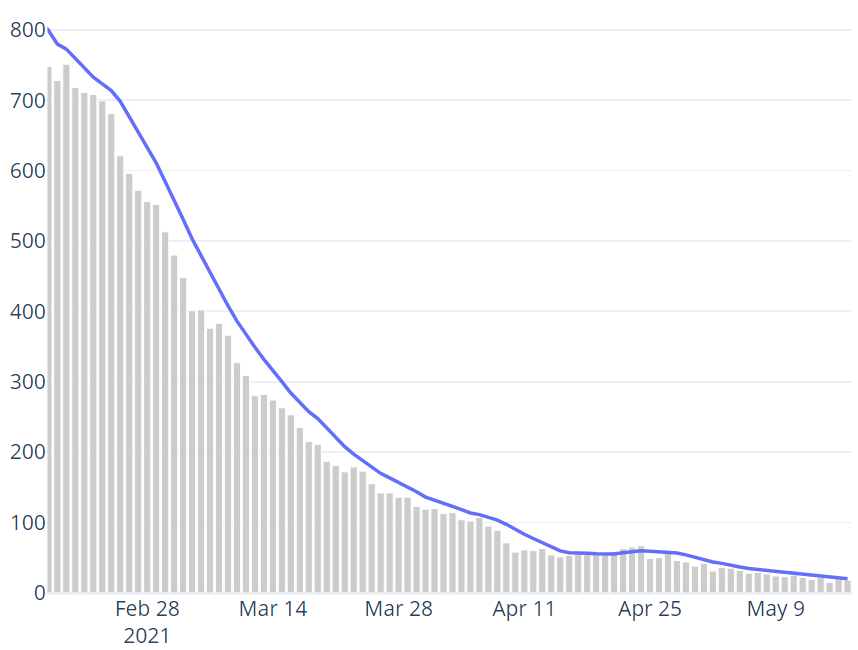
Overall invasive ventilated bed occupancy (7 day rolling average)
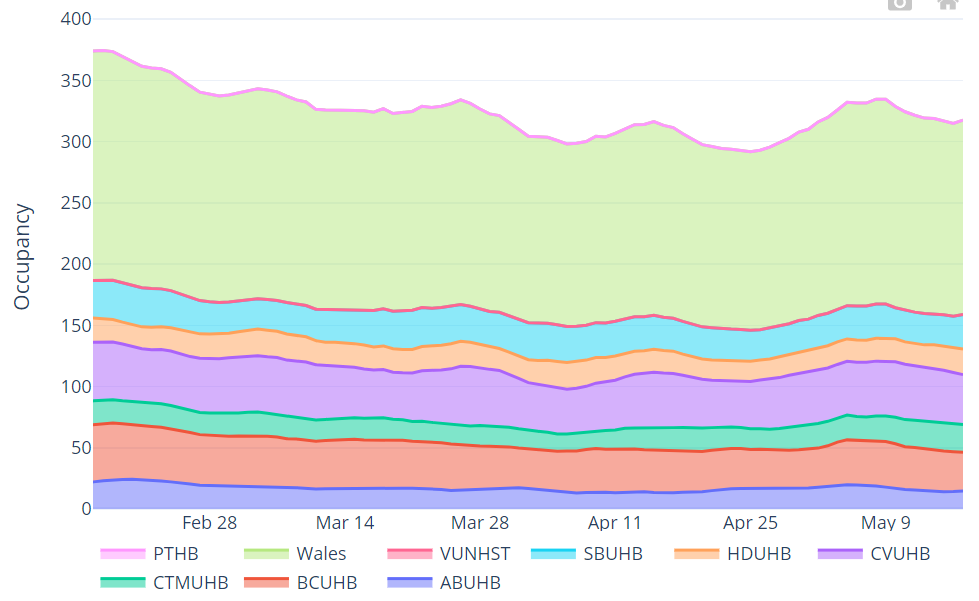
Invasive ventilated bed occupancy for suspected and confirmed COVID-19 positive patients (7 day rolling average)
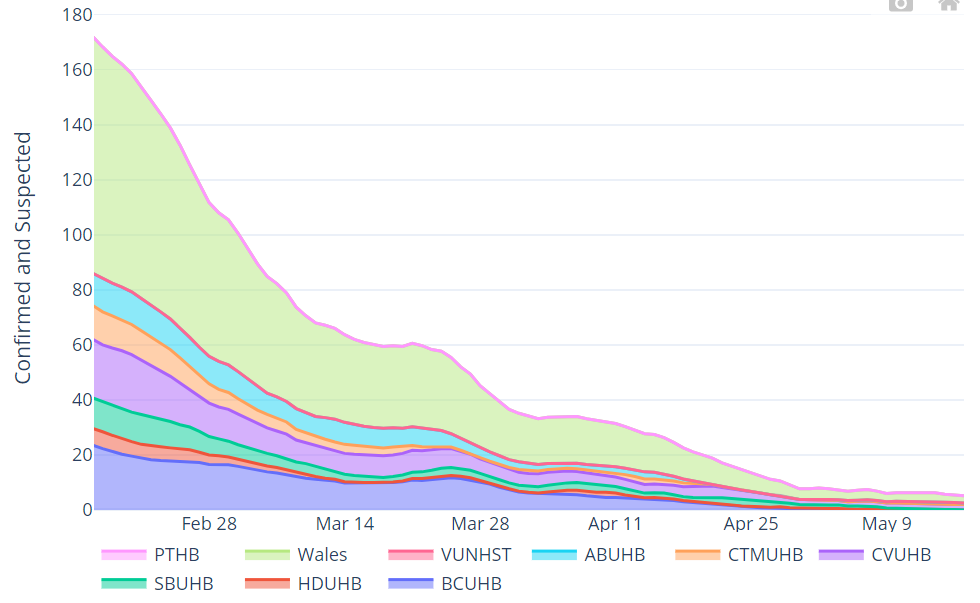
Hospital bed occupancy for suspected and confirmed COVID-19 positive patients (7 day rolling average)
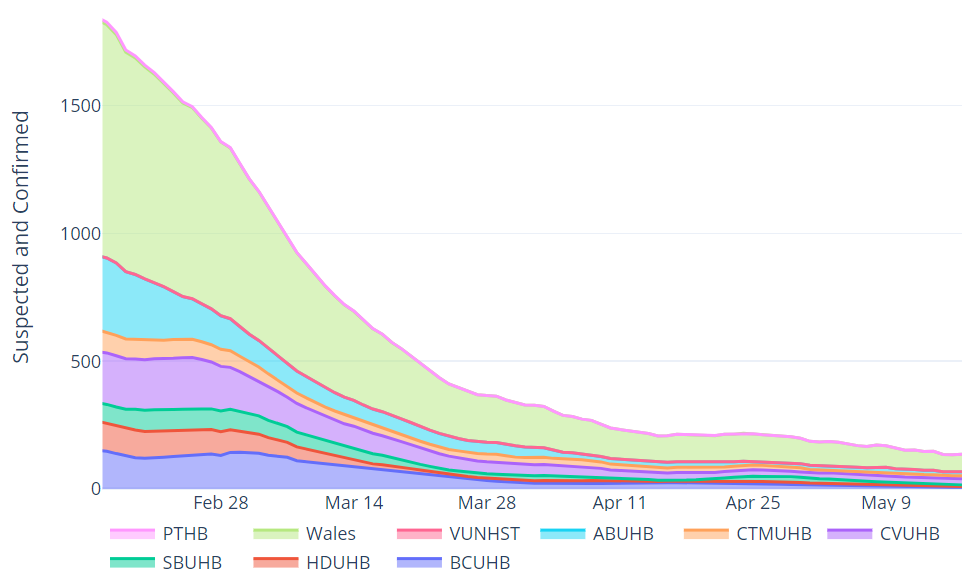
Number of adult care homes reported an ongoing outbreak/incident (last 7 days)

What is the situation with education, children and young adults?
Childcare settings
The latest National SBAR covering the week of 10 May to 16 May reported no new or ongoing clusters in childcare settings.
Schools
At the time of writing for the National SBAR to 16 May, 5 new clusters and 7 ongoing clusters were reported to be associated with schools. There were 6 incidents attributed to a school setting and 3 attributed to household, social or extra-curricular activities (figures do not include data from Cardiff & Vale). One IMT reported 2 separate school clusters linked to family parties, which has led to a total of 79 students and 2 staff members having to self-isolate. Source: National SBAR. Confirmed case incidence remained stable in those aged under 20 years old in the most recent week ending 16 May.
IMTs continue to report that infection observed in pupils and staff are commonly the result of community and social interactions outside the school setting, with the acknowledgement that the incidence associated with schools reflects wider community transmission.
Weekly COVID-19 incidence per 100,000 population for school age children and young adults in Wales (data as at 19/05/21)
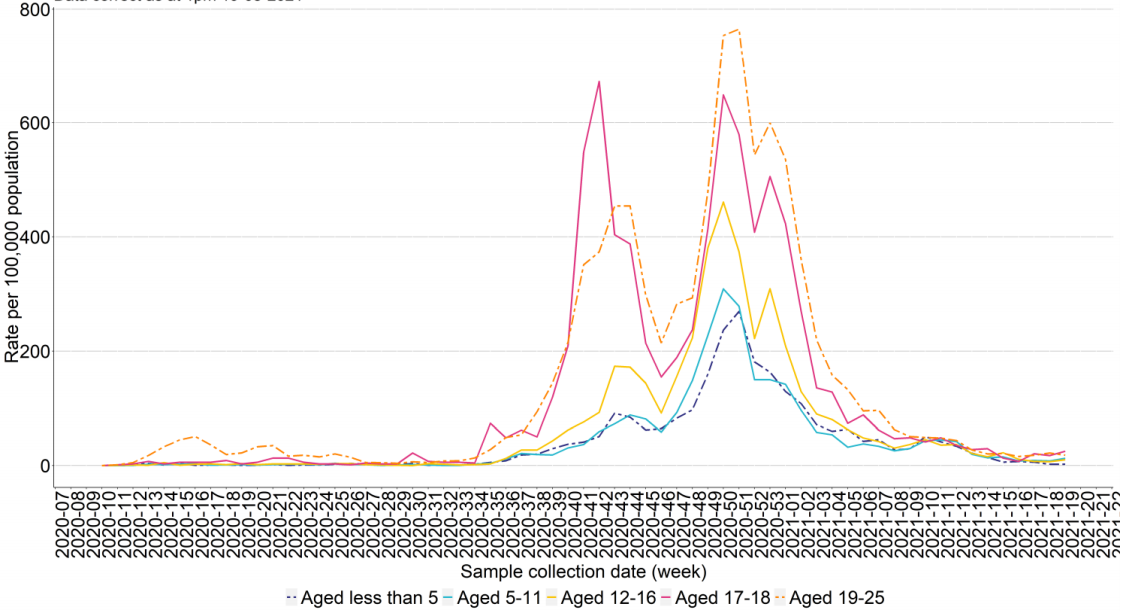
Schools with more than one COVID-19 case identified within the last 21 days, excluding 54 schools with 1 COVID-19 case
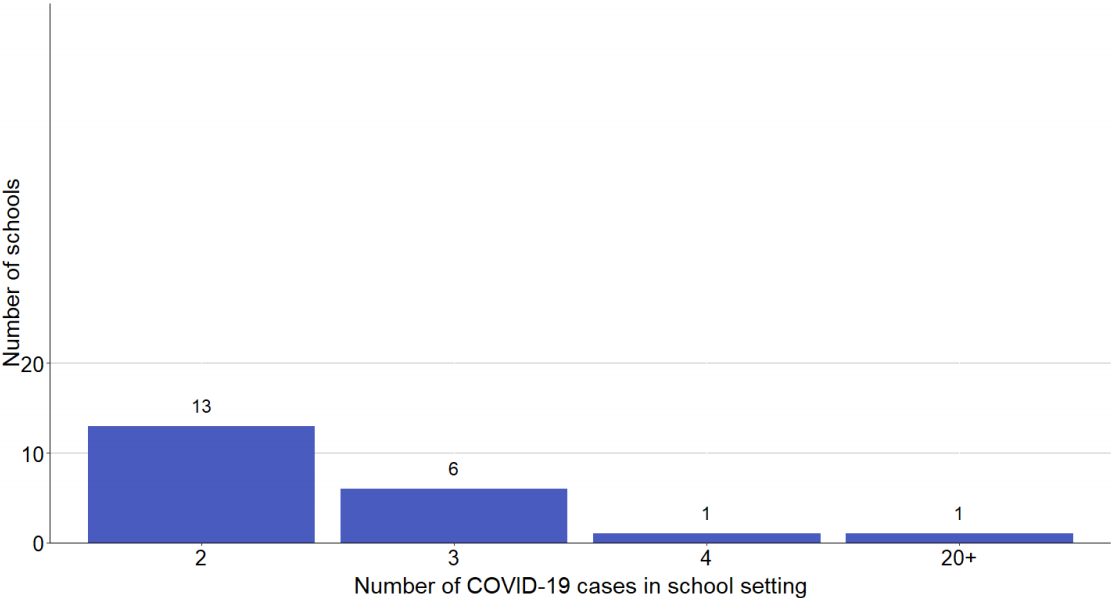
Epidemiological curve of cases in all staff and pupils linked to a school between 01 September 2020 to 17 May for all Wales maintained schools
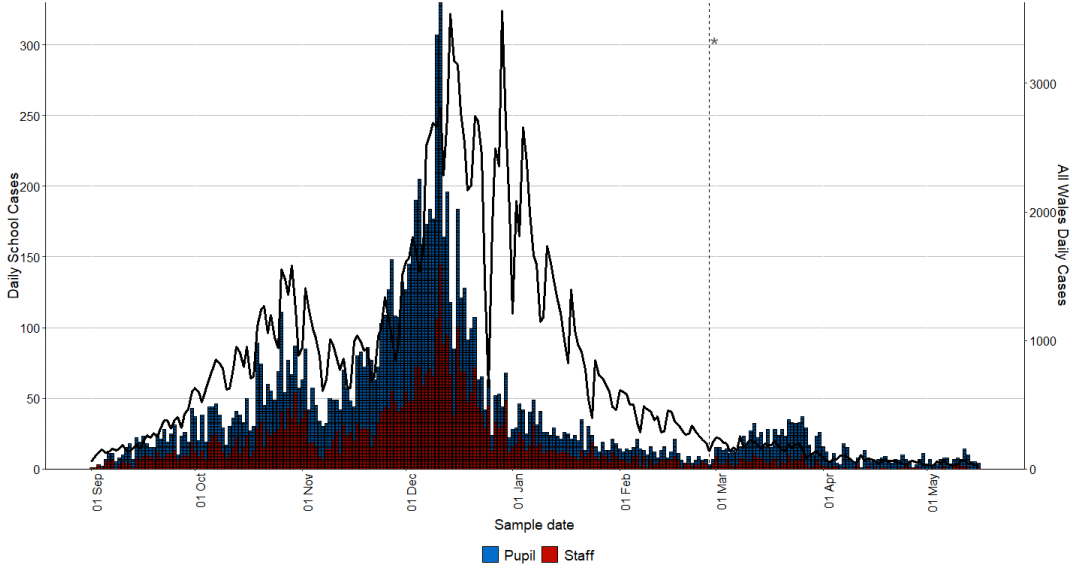
School Attendance
An average of 90% of all pupils were present in school over the week of 10 May to 14 May. This information is provisional and will be revised on 26 May. Source: Stats Wales.
Pupils present by day in Wales, from 7 September 2020

HEIs report cases notified to them by students and staff. From 1 February 2021 most HEIs have changed the way in which they report data, with positive cases referring only to students or staff attending campus or returning to the local area for study (with the exception of University of Wales Trinity St David's who are unable to split cases on this basis). Over the past week, the 7-day rolling average has been less than 2 positive COVID-19 cases for all HEI's. Source: Stats Wales.
We now also capture data via the National SBAR from local IMTs. There were 2 new clusters and 6 on-going clusters over 2 health boards relating to HEIs. One IMT reported that two clusters in University Halls of Residence have been under active management. Following the cluster reported last week mobile testing unit (MTU) deployment led to 99 residents receiving testing with 5 further cases now reported. There have been no further cases reported from the other affected residences. Source: National SBAR.
There is currently voluntary lateral flow device (LFD) testing of childcare staff, school staff, FE and HEI staff; FE and HE students, and older secondary school aged pupils. Detailed information on LFD test outcomes is not yet available.
7 day rolling average of positive cases in Welsh universities 27 September to 16 May 2021
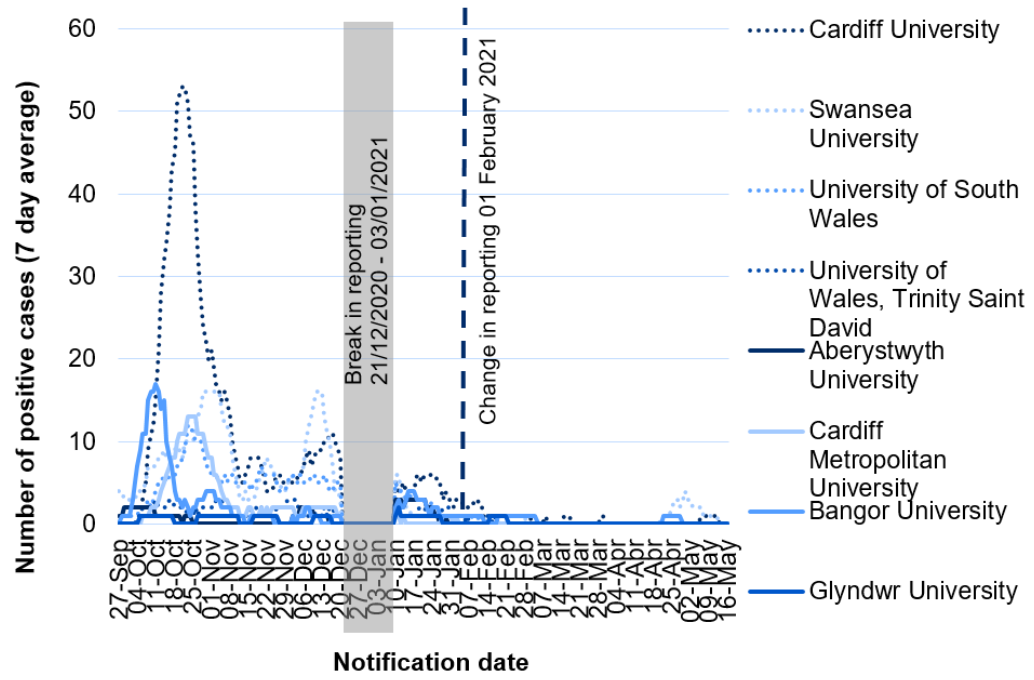
Please note: Due to accuracy and timeliness limitations with the capability of our surveillance systems, distinguishing exact case associations between children over 19, school staff and/or family members is currently not possible. We are looking to develop this with local health protection officers.
What does the situation look like going forward?
Based on the current rates observed with current restrictions:
- Cases – the probability of incidence greater that 100 per 100,000 remains low for all local authorities. The figure illustrates the probability (between 0 to 100%) of incidence being greater than 100 per 100,000. Source: Imperial College London
Probability of greater than 100 per 100,000 cases by local authority, Wales
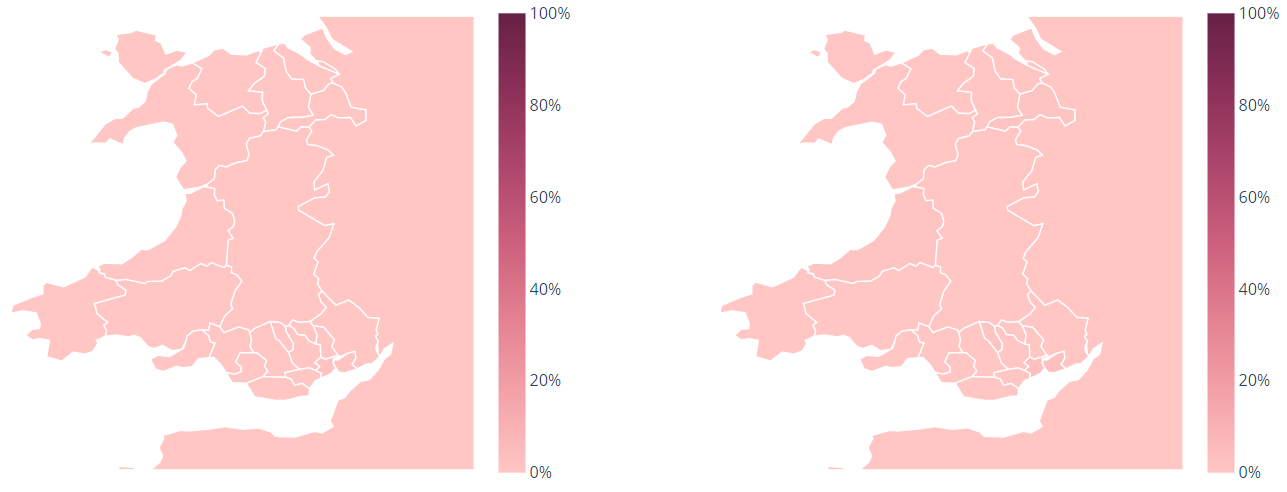
- Deaths per day - continue to see small numbers over the next four weeks. Source: Modelled medium term projections, SAGE, 11 May
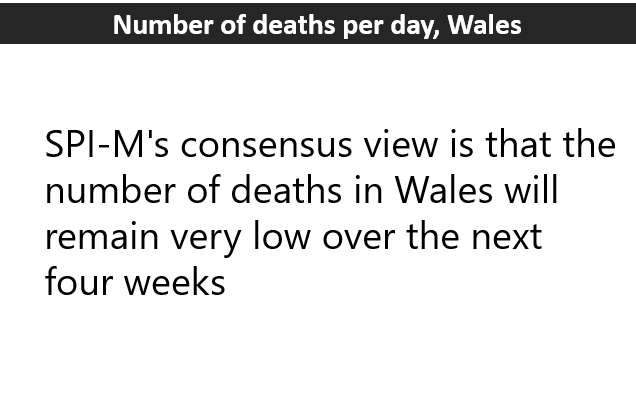
- Hospitalisations per day - continue to decrease to under 1 per day over the next four weeks. Source: Modelled medium term projections, SAGE, 18 May
Hospitalisations per day, Wales
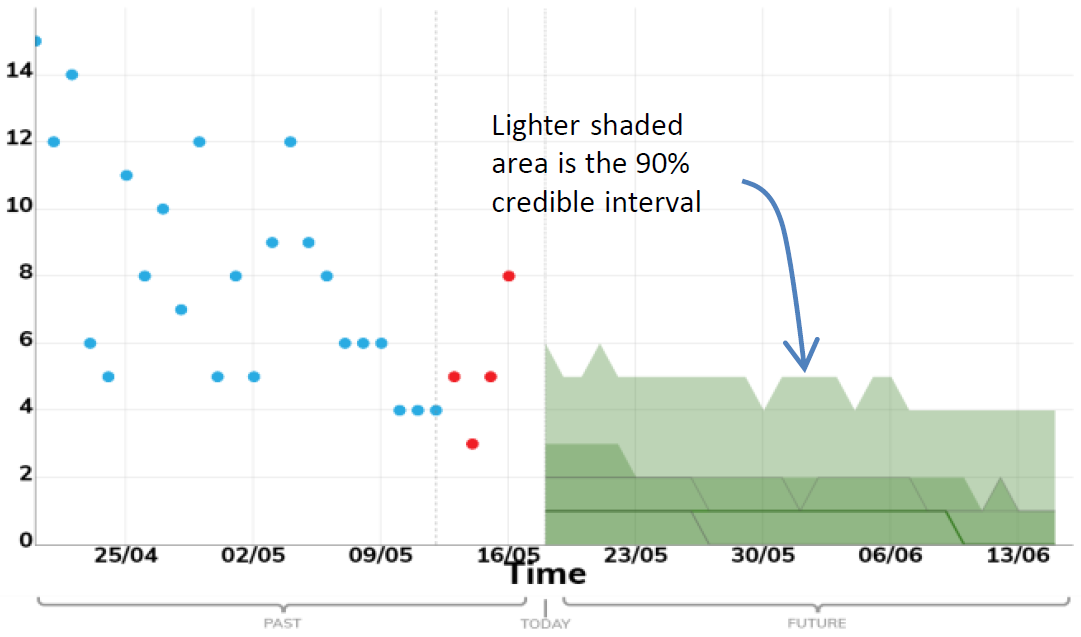
These projections are based on current trends and will not fully reflect the impact of policy or behavioural changes over the past two to three weeks. They are not forecasts or predictions.
Projecting forwards is difficult when numbers fall to very low levels, therefore SPI-M-O have decided to pause producing medium term projections where this is the case. The small numbers can also introduce apparent inconsistency as regions are aggregated.
Mobility data, adherence and UK comparison
The most recent mobility data shows a growth following the initial sharp increase seen after the easing of restrictions in several areas relating to travel and re-opening of non-essential retail on 12 April, with some categories showing little change. Source: Google
Mobility data by location of trip
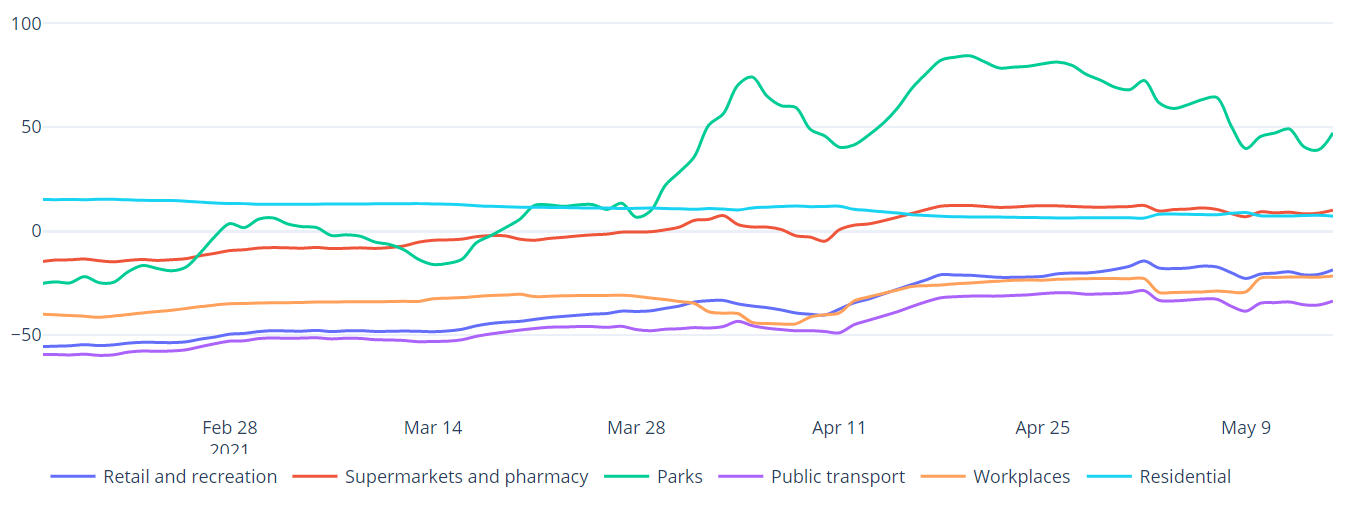
Source: Google
Adherence
New IPSOS MORI data for the period 23 – 27 April for Wales shows reductions in some categories since the previous survey wave 4 weeks ago, most notably a large reduction in those making essential trips only. Social-distancing and wearing of face coverings remains steady. Note this is self-reported adherence and will be affected by individuals understanding of the rules and guidance. Source: IPSOS MORI
Results from the Coronavirus (Covid-19) Infection Survey, 9 to 15 May
Rates continue to be low across all four UK countries for the week ending 15 May. Positivity rates appear to have increased in England, remained stable in Wales and decreased in Scotland. The trend in Northern Ireland is uncertain.
During the most recent period, is estimated that an average of 700 people in Wales had COVID-19 (95% credible interval: 100 to 2,000), equating to around 1 in 4,340 people. This compares to around 1 in 1,110 people in England, around 1 in 1,960 people in Scotland, and around 1 in 1,550 people in Northern Ireland.
Positivity rates (%) across UK countries since 28 March 2021
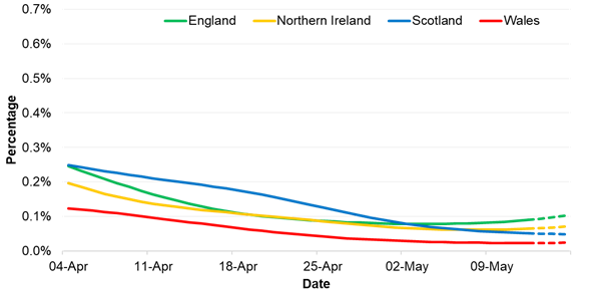
Source: Office for National Statistics COVID-19 Infection Survey
Key risks and sources
Key risks
Transmissions, incidence and prevalence
Overall transmission is generally decreasing and relatively low.
NHS Capacity
COVID-19 pressure on the NHS continues to improve. Some fluctuations are likely to occur, due to low numbers.
Mortality
Remains at a generally low level.
Variants
More cases of VOC21APR-02 (Indian variant) have been detected in Wales, although numbers remain low. There is strong evidence of increased transmissibility and local intervention will likely be required to prevent uncontrolled growth and wider community transmission.
Immunity and vaccines
2.95 million doses of COVID-19 vaccine were given in Wales. Of the 2.95 million doses given nationally, 2.05 million were first doses and 0.92 million were second doses.
